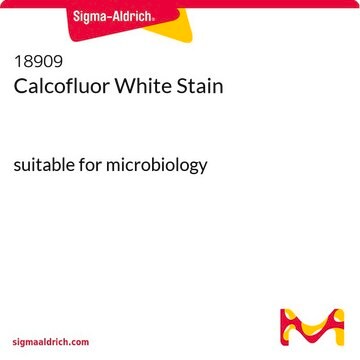This product has not been tested for any specific application, including in vivo use. Suitability would have to be determined experimentally by the end user. Historical information suggests that a concentration of 0.5% Evans Blue in PBS at pH 7.4 has been used successfully in staining tissue sections. This concentration may also be effective starting point for in vivo applications. Please refer to available literature for additional information.
推荐产品
产品名称
伊文思蓝, Dye content ≥75 %
表单
powder
组成
Dye content, ≥75%
技术
titration: suitable
应用
diagnostic assay manufacturing
hematology
histology
储存温度
room temp
SMILES字符串
[Na+].[Na+].[Na+].[Na+].Cc1cc(ccc1\N=N\c2ccc3c(cc(c(N)c3c2O)S([O-])(=O)=O)S([O-])(=O)=O)-c4ccc(\N=N\c5ccc6c(cc(c(N)c6c5O)S([O-])(=O)=O)S([O-])(=O)=O)c(C)c4
InChI
1S/C34H28N6O14S4.4Na/c1-15-11-17(3-7-21(15)37-39-23-9-5-19-25(55(43,44)45)13-27(57(49,50)51)31(35)29(19)33(23)41)18-4-8-22(16(2)12-18)38-40-24-10-6-20-26(56(46,47)48)14-28(58(52,53)54)32(36)30(20)34(24)42;;;;/h3-14,41-42H,35-36H2,1-2H3,(H,43,44,45)(H,46,47,48)(H,49,50,51)(H,52,53,54);;;;/q;4*+1/p-4/b39-37+,40-38+;;;;
InChI key
ATNOAWAQFYGAOY-GPTZEZBUSA-J
基因信息
human ... PTPN1(5770) , PTPRF(5792)
正在寻找类似产品? 访问 产品对比指南
一般描述
应用
警示用语:
Danger
危险声明
危险分类
Carc. 1B
储存分类代码
6.1C - Combustible acute toxic Cat.3 / toxic compounds or compounds which causing chronic effects
WGK
WGK 3
闪点(°F)
Not applicable
闪点(°C)
Not applicable
-
What amount and concentration should I use Evans-Blaun injecting it into the ear skin of a mouse to see Evans-Blue in the draining Lymphnodes afterwards?
1 answer-
Helpful?
-
-
How to prepare a stock 1% solution using E2129, and is ther any guidance on its use?
1 answer-
A 0.5% solution of Evans Blue in PBS, pH 7.4. Product P3813 should be used as the PBS, which will serve as the stock solution. For use, 3-4 drops should be added to 100 mL of PBS P3813. This should be used as the final rinse with a 5-minute wash. After rinsing briefly, coverslip the sample.
Helpful?
-
-
What is the stability of the E2129 solution once prepared?
1 answer-
The stability of the solution will depend on whether the solutions are sterile filtered or contaminated through routine use. It's recommended to store the solutions in the dark at 2-8°C.
Helpful?
-
-
Should Evans Blue solutions for fluorescent assays be aged or cured for 7 days before use?
1 answer-
While some dyes require aging before use, there is no indication that Evans Blue solutions need to be aged or cured before use.
Helpful?
-
-
How do I dilute 80% purity evans blue powder into a 2% solution with normal saline?
1 answer-
This product is soluble in water at 60 mg/mL. For typical laboratory staining applications, a 1X PBS solution is also commonly used. Solubility in normal saline has not been evaluated, but rates are expected to be similar. A 2% solution would be 20 mg/mL. The dye content is lot-specific and reported in the Certificate of Analysis. Please see the link below to access a sample or batch-specific Certificate:
https://www.sigmaaldrich.com/product/sigma/e2129#product-documentationHelpful?
-
-
What is the solution stability of Product E2129, Evans Blue?
1 answer-
This product is rather stable in aqueous solution and may be autoclaved at 15 psi for 30 min. However, dye made up in physiological saline should not be autoclaved.
Helpful?
-
-
What is the Department of Transportation shipping information for this product?
1 answer-
Transportation information can be found in Section 14 of the product's (M)SDS.To access the shipping information for this material, use the link on the product detail page for the product.
Helpful?
-
-
How should Product E2129, Evans Blue, be dissolved?
1 answer-
This product is soluble in water, alcohol, acids and alkalies.
Helpful?
-
-
Can Evans Blue, Product E2129, be used as a counterstain for FITC?
1 answer-
This product can be used as a counterstain in immunohistochemistry when using FITC. After staining for immunofluorescence, dip sections in a 0.1% (w/v) in water solution of Evans Blue for 5-10 minutes. Rinse well in fresh PBS or water before coverslipping. Reference: Immunocytochemistry, Theory and Practice, p. 82 (1988).
Helpful?
-
-
What is the shelf life of Product E2129, Evans Blue?
1 answer-
This product has a retest date of 4 years. This information can be found on the Certificate of Analysis.
Helpful?
-
Active Filters
我们的科学家团队拥有各种研究领域经验,包括生命科学、材料科学、化学合成、色谱、分析及许多其他领域.
联系技术服务部门









